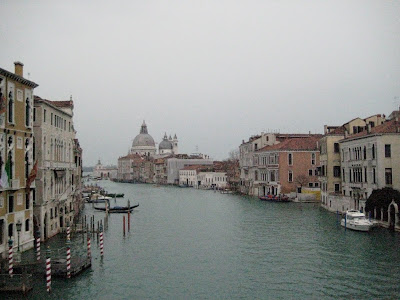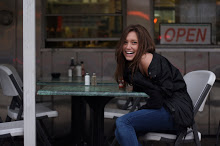Thursday, February 18, 2010
Music
To learn more about Playing for Change, both the project and the organization, check out the website at www.playingforchance.com .
Sunday, February 14, 2010
Oh No!

Thursday, February 11, 2010
Pop-Art and its Frenemies
 A few weeks ago Seth introduced me to the work of Austrian artist Erwin Wurm, whose Fat Convertible (2005) has been on my mind ever since. Wurm made a series of "fat cars," by essentially stuffing existing cars with styrofoam and fiberglass, thereby turning the sporty vehicles into comical, cartoonish (art) objects. In keeping with the current fad, Wurm is asking us to consider the connections between power, wealth, consumption, health, obesity, and perhaps the ways advertising affects each of these entities, and how art plays a role. As I see it, the most obvious of the many messages here is: when we lack the ability to practice restraint, we become useless. (Think Pixar's Wall-E.)
A few weeks ago Seth introduced me to the work of Austrian artist Erwin Wurm, whose Fat Convertible (2005) has been on my mind ever since. Wurm made a series of "fat cars," by essentially stuffing existing cars with styrofoam and fiberglass, thereby turning the sporty vehicles into comical, cartoonish (art) objects. In keeping with the current fad, Wurm is asking us to consider the connections between power, wealth, consumption, health, obesity, and perhaps the ways advertising affects each of these entities, and how art plays a role. As I see it, the most obvious of the many messages here is: when we lack the ability to practice restraint, we become useless. (Think Pixar's Wall-E.)Something about Wurm's work seemed extremely familiar to me, though I had never seen it before. Perhaps most obviously, Wurm’s critique and celebration of consumerism and the values of contemporary society keeps with the tradition of Pop art from the 50's through the present.

Yet, after some thought about Wurm’s work, I realized that in terms of style, and perhaps message as well, Wurm's “fat series,” (he’s also made a fat house, etc,) is quite similar to Claes Oldenburg's The Store (1961). The Store was a storefront on NYC’s Lower East Side, which Oldenburg opened from December 1961 to January 1962, for the purpose of emphasizing the connections between art, commodity, and commerce. At The Store, Oldenburg created and sold food and household items, thereby elevating everyday goods to the status of art objects. It is also possible to analyze Wurm’s work through that lens, as of his early works, Wurm said, “I am interested in the object, in liberating it from its field, giving it a new validity and meaning. It is integrated in a different system of values and ideas: in that of art. In this way it loses its function and takes on another.” (Erwin Wurm interviewed by Desirée Schellerer for Design Vienna.) Whether or not you can see the similarity between the messages of the two artists, in terms of physicality, it is quite obvious that Wurm’s fat works are “high-tech” versions of Oldenburg’s swollen, glistening everyday, turned art objects.

On a more basic, or superficial level, the title of Wurm's work is eerily evocative of Joseph Beuys' creepy work. Beuys’ works are too disturbing to delve into in this lighthearted post, but in the 1960’s Beuys created a “fat series” of his own. To the right you can see Beuys’ Fat Battery (1963). Though extremely different in terms of physical appearance and message, I have to wonder if Wurm was deliberately channeling Beuys when naming his work. (Sorry for the rather cryptic and probably curiosity sparking nature of this paragraph, I promise a detailed post on Beuys is coming soon…)
So, funny and alluring as Wurm's "fat series” is, it just might not the most original group of artworks ever, but don't worry, the “fat series” is not all that Wurm has produced. If you want to see some crazy, cutting edge Wurm work, check out his House Attack (2006), an instillation that he implanted on the facade of Vienna's Museum Moderner Kunst (MUMOK). Of the work, Edelbert Kob, curator of MUMOK, said “House Attack is… A symbol for conservative, small-minded longings, the single-family house collides into the museum as a temple to the muses, and the museum itself now also becomes part of the sculpture. House Attack confuses our perception of art and everyday reality…”

Wednesday, February 10, 2010
Roman Remains
 This past weekend Naomi and I went to Rome! The weekend was a wonderful whirlwind of site seeing, art appreciating, eating, and spending time with old and new friends.
This past weekend Naomi and I went to Rome! The weekend was a wonderful whirlwind of site seeing, art appreciating, eating, and spending time with old and new friends.







Bringing Music to the People
 My friend Jess knows about the coolest projects! British artist Luke Jerram (www.lukejerram.com) created a traveling instillation called "Play Me I'm Yours" in which he put pianos on the streets in various neighborhoods to give people from all different backgrounds and walks of life the opportunity to make music! Check out the project's website to learn more and to find out about the locations of Jerram's street pianos: www.streetpianos.com .
My friend Jess knows about the coolest projects! British artist Luke Jerram (www.lukejerram.com) created a traveling instillation called "Play Me I'm Yours" in which he put pianos on the streets in various neighborhoods to give people from all different backgrounds and walks of life the opportunity to make music! Check out the project's website to learn more and to find out about the locations of Jerram's street pianos: www.streetpianos.com .
The Big Draw
 In an art class I took during my freshmen year of college I learned that our artistic skills remain at the level of the time we stop producing art. In other words, as little kids we all draw, but by the end of grade school when mandatory art classes are dropped from our curriculums, many of us stop utilizing our artistic powers leaving them stagnate, and perhaps even causing them to regress. Not that we all need to be master artists, and by no means is that the goal of "The Big Draw," but as Malcolm Gladwell, (referencing scientific studies by neurologist Daniel Levitin,) explains in his book Outliers, 10,000 hours are required to become a master, or expert in anything.
In an art class I took during my freshmen year of college I learned that our artistic skills remain at the level of the time we stop producing art. In other words, as little kids we all draw, but by the end of grade school when mandatory art classes are dropped from our curriculums, many of us stop utilizing our artistic powers leaving them stagnate, and perhaps even causing them to regress. Not that we all need to be master artists, and by no means is that the goal of "The Big Draw," but as Malcolm Gladwell, (referencing scientific studies by neurologist Daniel Levitin,) explains in his book Outliers, 10,000 hours are required to become a master, or expert in anything. Anyway, the initiative sounds amazing and has received international acclaim. I believe that The Drawing Center of NYC participated in 2009, does anyone else know of other NY institutions that took part? If you are interested in learning more about "The Big Draw," or in registering your organization / institution, visit the website of the Campaign For Drawing at www.campainfordrawing.org .
Tuesday, February 9, 2010
Hands

A lot has happened since I last updated! Naomi Telushkin, one of my lifelong best friends from NYC visited, we went to Rome, (details to follow,) old interns left and new interns arrived, my roommates and I hosted the first full blown Peggy Guggenheim Collection intern house party of 2010, and I got a terrible infection in the ring finger of my right hand.

Tuesday, February 2, 2010
A Happy Space
I'm sorry for my lack of updates recently, I've been busy moving into my new apartment! So, I haven't quite expressed just how terrible my last place was, but as Talia put is best, "this place is like living in camp!" Which, for those of you who don't know, means shoes in the shower, mold growing everywhere, floors so dirty they simply can't be cleaned, no way of washing clothing, virtually no kitchen, and absolutely no closets... you get the picture. But enough of the negativity because this new place is amazing and I'd rather focus on that! And the best part!?! Naomi Telushkin, my best friend from NYC, has just arrived to enjoy my new place with me, and infuse it with positive energy!
Actually, my living situation since arriving in Venice reminds me of a Jewish folk tale that I will share with you:
A poor man lived with his wife and six children in a very small home. They were always getting in each other's way and there was so little space they could hardly breathe! The man went to the rabbi to ask for advice regarding the overcrowding. The rabbi told the man to bring all of his cows and chickens into his home to live with him and his family. The poor man was astonished to hear this advice from the rabbi, but did as the rabbi said. The next day the poor man ran back to see the rabbi and said, "What have you done to me, Rabbi? My life is absolutely terrible now!" The rabbi responded, "Go home now and take the animals out of your house." The poor man did as the Rabbi said and the next day he came running back to the rabbi and with a big smile on his face he said, "Thank you rabbi, our house is so quiet and spacious now, we are so grateful!"
Check out this short tour of my new apartment, which I made using the FLIP my Abbagave me for Hanukkah!
*Oops, the video file is too large for me to upload with my dinky internet - I will upload it as soon as I make to to an internet cafe. Thanks for your patience!*
